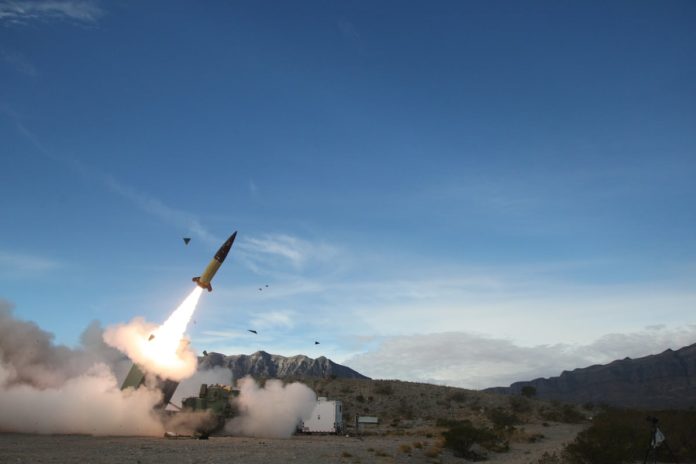Ukraine’s innovative drones are damaging forces and war-supporting industry across western and southern Russia. In a visit to the White House on Sept. 26, Ukrainian President Volodymyr Zelenskyy asked for more help for long-range strikes. He received modest assistance. President Joe Biden said the U.S. would provide the Joint Standoff Weapon (JSOW), an unpowered glide bomb with a range of over 60 miles.
Ukraine had wanted more. It has repeatedly sought permission to use U.S.-built Army Tactical Missile System (ATACMS) missiles for long-range strikes deep in Russia. They have a range of up to 190 miles and, with their speed, are better able to hit mobile targets. Prior to Zelenskyy’s visit, there were hints the U.S. might provide Joint Air-to-Surface Standoff Missiles (JASSM). Unlike ATACMS missiles, these missiles are abundant in the U.S. arsenal, and their stealth capability make them more effective at hitting defended targets.
RELATED
Sentiment in NATO is growing to give Ukraine more scope for action. This month the European Parliament asked European Union members to “immediately” lift deep strike restrictions, and so have top U.S. House Republicans and several leading congressional Democrats. Nonetheless, the U.S. approach remains hesitant.
There may be risks. On Sept. 25, Russian President Vladimir Putin warned an attack on Russia by a state backed by a nuclear power could lead to a nuclear response. He often cries nuclear wolf, but this time, his timing suggested worry that Biden might cave to pressures and unleash Ukraine to conduct more deep attacks.
A Russian nuclear response, however, seems unlikely and would probably bring little, if any, military gain. Russian troops are not trained to fight on a nuclear battlefield, as in the Cold War. Ukraine has few, if any, concentrated, high-value military targets. Chinese President Xi Jinping and Indian Prime Minister Narendra Modi have warned Putin not to go nuclear, while Biden has warned of “catastrophic consequences” if he does.
There is also a risk that some JASSMs might miss their targets or not be fully destroyed. Russia — and China — could analyze the debris to try to learn more about their stealth capability and sensitive electronics.
Time and again when Ukrainian forces have surprised or shocked Russia — from destroying or damaging one-third of its Black Sea fleet to seizing territory in Russia’s Kursk region — the Kremlin’s response has been weak. Suffering steep manpower losses and needing arms from Iran and North Korea, Russian forces may face limitations.
To its credit, Ukraine is doing a lot on its own to strike deep inside Russia. On Sept. 18, it carried out a stunning attack in Russia’s Tver region, blowing up a huge weapons depot in a blast akin to an earthquake. To overwhelm air defenses, Ukraine used over 100 slow-flying drones. The depot was 300 miles away from Ukraine, well beyond the 190-mile range of ATACMS missiles.
A welcome surprise has been Ukraine’s high-tech drone innovation. Former CIA Director General David Petraeus called it “unprecedented” in scale and pace. Even more is coming. Last month, Zelenskyy said Ukraine had deployed its first high-speed missile-drone, the Palianytsia.
But Ukraine needs more long-range strike power than its own aviation sector can provide. U.S. arms may be a valuable complement, despite their higher cost.
Last spring the U.S. began sending the long-range variant of ground-to-ground ATACMS missiles to Ukraine for use inside its territory. In occupied Crimea, they have ravaged Russia’s navy and air defenses and supporting infrastructure. ATACMS missiles are responsive and can hit mobile targets that elude drones. In June, the U.S. allowed Ukraine some added flexibility — to strike across the border inside Russia with ATACMS missiles wherever enemy forces were engaged in attacks.
On Sept. 26, Biden also promised to send hundreds more Advanced Medium-Range Air-to-Air Missiles (AMRAAM). Armed with them, Ukraine’s F-16s could shoot down some Russian combat aircraft in flight before they release devastating glide bombs.
The long-range strike mission is important for Ukraine, but so are other factors. It faces challenges in several areas, including a soldier shortage, inadequate defensive fortifications and uncertainties about future Western aid.
Nonetheless, the U.S. could benefit Ukraine by doing more to help it to conduct long-range strikes in Russia. Neither U.S. weapons nor Ukraine’s, by themselves, are enough. Together, they could raise the cost to Russia of its perfidy and help strengthen European security.
William Courtney is an adjunct senior fellow at the nonprofit, nonpartisan RAND research institution and was U.S. ambassador to Kazakhstan, Georgia, and a U.S.-Soviet commission to implement the Threshold Test Ban Treaty.
John Hoehn is an associate policy researcher at RAND and a former military analyst with the Congressional Research Service.


